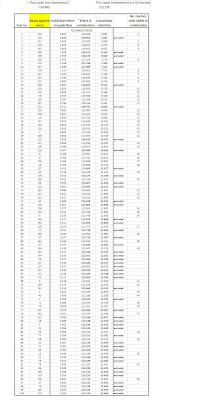As discussed previously, from the screening runs there are 127 reaches where increasing channel and floodplain roughness to simulate the adding on a Catchment Riparian Intervention Measure (CRIM) decreased downstream peak flow. It was decided that the 100 reaches with the greatest individual impact would be explored in combination.
Brief method:Essentially for looking at CRIMs in combination I ranked the 100 reaches in order of how effective increasing channel and floodplain roughness (to simulate a CRIM e.g. debris dam and riparian vegetation planting) of that single reach in question, is on reducing downstream peak flow. So, for example the best reach reduces peak flow by ~3.5 cumecs when roughness is increased in just that reach.
A CRIM was simulated along the reach with the largest individual effect. Then a CRIM was also added to the reach with the second largest effect on downstream peak flow - a CRIM was therefore simulated in both of these reaches. If simulating a CRIM in these 2 reaches reduced downstream peak flow by more than simulating a CRIM in one reach both were retained in combination. I then simulated a CRIM in the third reach and so on. Each time a CRIM was simulated the
cumulative effect on downstream peak flow was recorded. If simulating a CRIM in a new reach did not increase the positive impact (cumulative peak flow reduction was reduced) this reach was rejected and excluded from future combinations.
The results can be seen in the table accompanying this blog. Please give feedback on the quality of the table.
IssuesYou can see from the table that the title 'reach applied (no.)' is highlighted yellow. These numbers are used in the model OVERFLOW to identify each reach and change, amongst other characteristics, roughness values. However they will have no meaning to those not using the model. Producing a figure with each reach numbered is not especially practical considering there are 234 reaches. This creates a bit of a problem for me in communicating the results, especially in terms of where I'm simulating an intervention.
There is also somewhat of a challenge in explaining the methods I have used; the process is likely to be very confusing to others. Hopefully the table will help you see the process I went through.
To think about/uncertainty:As previously discussed, these results must be viewed with an appreciation of the uncertainty associated with the model and its inputs.
For looking at the combination of CRIMs I have ranked reaches primarily order of effect on
peak flow. Whilst a consideration was made of reaches with a positive impact on the flood volume above approximate channel capacity this was not the focus. There may be reaches where increasing roughness reduces excess flood volume by a large amount, whilst having a slightly negative effect on peak flow; I will try and look at such reaches in some form.
The results presented here are for one combination of interventions. A different combination could suggest a different pattern of effects and different key reaches to focus on - this would reduce uncertainty of results/recommendations.
Is simulated roughness higher than might be expected from CRIMs in reality? I hope to get results from simulating the effects of increasing channel roughness by a smaller amount.
Again feedback is much appreciated, especially regarding any problems understanding the method or results, or issues with the presentation. I would like the blog to be as easy as possible to follow so results and the uncertainty can be understood.



